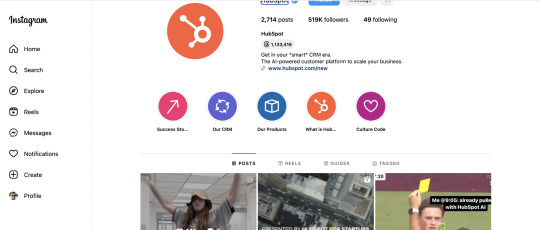#SaaS Solutions
Explore tagged Tumblr posts
Text
Develop and implement scalable and secure SaaS solutions
Answer a few questions to kickstart your SaaS development journey. From defining essential functions and handling data to multi-tenant support and business plan alignment, we deliver robust and scalable SaaS platforms tailored to your needs.
3 notes
·
View notes
Text
How To Create A Content Marketing Strategy For Your SaaS Business

Whether you're starting conversations that engage your target audience, sharing information that positions your SaaS business as an industry leader, or simply drumming up business for your SaaS product, you need an effective SaaS content marketing strategy.
Why you may ask?
Because 63% of customers cite web pages during their evaluation process. And on the average, companies that blog receive 434% more indexed pages. If, on an industry-wide scale, you have nearly 10 times more leads from long form blog posts than short ones, then content marketing is a priority if you want to grow your SaaS business long term.
In this guide, we'll discuss SaaS content marketing strategy. And by the end, you'll know what content strategy is, why you need one and when to apply it. Then you'll get a step-by-step process of creating a content strategy unique to your SaaS business.
Defining SaaS Content Strategy

If you don't understand content strategy, we'll explain what it is before we get to the why and when.
So what is content strategy?
Content strategy is simply all the content processes a business employs to get prospects to buy their product or service. There's
#Audience Research
#Business Model
#Content Ideation
#Media Platforms
#Content Creation
#Distribution &
#Evaluation
And as a SaaS business owner, SaaS content strategy is simply a content strategy that accounts for your SaaS business model.
SaaS companies like Canva, Buffer and HubSpot have executed robust content marketing strategies that have scaled their lead generation and subscription efforts.
Specifically, Grammarly has a blog that educates their readers on writing styles and technique. Their blog has over 100,000 subscribers and their content has over 5 million views.
These readers get freemium access to their editing tool. They number 30 million users. And a good number of these readers end up paying for their editing software.
As a SaaS business owner, you can aim for similar success, cheap and exponential business growth, with an effective SaaS content strategy.
Benefit Of SaaS Content Strategy

Focus stands out amongst content strategy benefits like exponential growth and cheap lead generation. Joe Pulizzi stressed the importance of content strategy and expanded on focus as a SaaS content strategy benefit when he said this…
"We need to create a business strategy for our content. That means saying no to many channels and content types, and focus on where we can build an asset, an audience, overtime."
- Joe Pulizzi
A good SaaS content strategy saves time and energy that would otherwise be spent talking to the void. Strategy quickly gets you closer to what works. By studying your target market, you discover not just what to say, but where and when to say it.
Let's take HubSpot for instance here.
HubSpot's blog posts are comprehensive guides to unlock business growth via sales and marketing. Their blog content has a strong bias towards explaining theories and practices. But on their Instagram page, we observe something different. Content is more conversational and personable. Learning takes a back seat to experience and entertainment.
Their blog readers and Instagram followers are different. And even when these audiences overlap, we see different attitudes for different platforms. And in this case, the same lead is in a different mindset depending on which platform they consume HubSpot's content.
We can see that HubSpot's approach to content creation and distribution considers platform culture when talking about the same topics. These content strategy insights come from studying market behavior on search engines and different social media platforms.
So now they don't have to work mindlessly. They have knowledge and a plan on how to use relevant content to generate leads and sales.
This is the process of creating a content strategy and you can do the same for your SaaS business.
When To Use SaaS Content Strategy

From time to time, I find founders and aspiring entrepreneurs asking when to use content strategy in their business.
My answer?
Start as soon as you can. In fact, you should have started yesterday even if you don't have a product or market. Surprised? Let me explain.
Early Stage SaaS Companies
You see, a content strategy is valuable because of what it makes you do. You can't have a strategy to engage a market if you first don't know your core service or product, and who would need your offer.
Say you're a digital marketer helping e-commerce stores increase website traffic. And you hope to sell software services to e-commerce store owners in the future. You could use a content strategy where you document your process of helping e-commerce websites grow their traffic.
Now you're engaging your market while figuring out other problems they may have that would be worth a SaaS tool. Before UberSuggest, Neil Patel ran his digital marketing blog for many years. He offered educational content to digital marketers and online entrepreneurs on how to grow their businesses. Now his SaaS tool, UberSuggest, helps entrepreneurs with keywords for their content marketing efforts.
Established SaaS Companies
On the other hand, established SaaS businesses can improve the value of their business by having another option to generate leads and sales. Outbound processes like cold calling and emailing can be effective and sustainable. But adding inbound processes like content marketing to the mix increase lead gen options and strengthens outbound processes too.
Regardless of where you are in your SaaS journey, creating a good SaaS content strategy keeps you in touch with your product and market.
Now having understood what a SaaS content strategy is and can do, let's get into the weeds of creating one.
Defining Your Market

All effective SaaS content strategy starts out with a defined market. As a SaaS business owner, ask yourself these questions…
Who needs what you sell?
Why do they have this need?
What would they feel like when said need is satisfied?
What else do they do outside finding said satisfaction?
These questions give you an opportunity to understand your market. Say you sell business software to freelance writers and content creators. Freelance writers and content creators need high paying clients and commercial success with their audience respectively.
But is that all?
It isn't. Dig deeper.
For a freelance writer, higher paying clients mean
Reduced Anxiety
Meaningful Work &
Time Freedom
And for the content creator, a profitable product they own means
Income Stability
Creative Freedom &
Work Satisfaction
As an owner of your business software, you now know what your editing or invoice software actually means to your market. You know their needs and what they'll feel like when satisfied.
So it's time to find them.
SaaS Content Strategy Platforms

We've answered the above questions for your hypothetical software business except for what content creators and freelance writers do outside their core jobs.
Answering the last question brings up more questions…
Do they consume business content from online gurus?
Do they take courses from fellow writers and bloggers?
What about search and social groups where they interact with fellow content creators and freelancers?
Remember, we're trying to find out their hangout spots online. So wherever they spend their time online is a potential content strategy platform. Content strategy platforms are places that shape your tone and approach to creating engaging content that converts prospects.
You can speak with your customers to get an idea of how they spend their online hours when they're not working. Of course you can't go around asking awkward questions like
'Where do you spend your time online?'.
Instead, you can say something like
'What's your most inspiring piece of educational content in the last 2 months?'
'Who's making content that gets you excited?'
'What obstacles do you face that often hinder your productivity?' (By the way, whoever is offering courses or creating content to solve that problem is a potential content strategy platform.)
Get a list of these content strategy platforms and go to work studying your market. You'll find yourself in reddit channels, comment sections of Instagram accounts and YouTube channels. You'll pick up Twitter trends and read blog comments.
Before long, the picture of your market becomes clear. You'll be full of content and distribution ideas for your content marketing campaign. Your SEO keyword search would be much more robust instead of staring at keyword software charts with frustration.
Back to our hypothetical software business. Your market research would take you to content strategy platforms like Ali Abdaal, Dan Koe, Zulie Rane, Gary Vee and Roberto Blake. These creators serve the typical content creator and freelance writer. Observe how they talk and what they talk about in the comment sections of these influencer accounts.
Now you know exactly what your market wants and you know how to create content for them.
It's time to engage and convert.
Engaging And Converting Your Audience

Many SaaS companies get it right up to this point but skid off track at this crucial bend. They lose because they want to engage their prospects on the company's terms. Don't make that mistake.
Remember our earlier conversation about HubSpot's approach to their blog and Instagram accounts?
Good.
They observed that business owners on search engines such as Google, have search intent to learn about new information and products to solve business problems. So HubSpot's blog attracts them with big prominent blog titles and small author bylines.
Blog Titles

Picture of HubSpot's SERP
Blog Titles and Author Bylines

Picture of HubSpot's Blog Post
You get the sense that it's ideas first before people. On the other hand, business owners and professionals who want to unwind while being social on Instagram, dictate HubSpot's Instagram approach to content creation. Here, social interaction and entertainment are priority over ideas and education.
Personality Over Theory

Picture of HubSpot's Instagram account
It's not enough to create content, you have to do so native to each platform. This is where strategy bleeds into tactics. Let's talk team building.
Building A Content Team
Having understood what it takes to create a practical SaaS content strategy, it's time to roll up your sleeves and get to tactics. You could start solo but at some point, you'd need to build a team.
We'll examine 4 factors that determine the success of your team. They're
Vision
Roles
Collaboration &
Accountability
We'll begin with vision.
Vision
Your vision is volume and creativity. You have a SaaS content strategy and ideas to engage your prospects. But to get results, you need to create and distribute as much content as possible.
We're talking 20-30 social media posts daily with at least 3-10 social engagements per post. Write blog posts, record podcasts and YouTube videos on a daily basis. Repurpose your long form posts for social. You want to find what sticks.
This is hard work but that's the real secret to content marketing success.
Especially at the beginning, you have to find out what actually works. So volume and creativity is the vision when hiring a content marketing team. At such volume, in 3-5 years, you'll evaluate content activity and do more of what engages your market. And consistent sales roll in.
There are no shortcuts to this game. It's not a sprint or a marathon, it's both. The long hard road is the easiest and shortest one. Get to work. As entrepreneurs, we instinctively understand that outbound processes like cold calling are a numbers game but we don't apply it to content marketing.
There are so many intangible content marketing skills that can only be mastered via the fire hose approach. So when building your content marketing team, your overarching vision is that big is better.
Roles
You want big and better, so it's time to get you a content marketing team who can achieve your goals. I'd say that there are 3 major content marketing roles.
Director
Manager &
Creative
When you were creating your content marketing strategy for your hypothetical SaaS company, you played the director role. In addition to setting the vision for content strategy, a director of content analyses and adjusts content efforts to achieve customer and company goals.
The manager is in charge of content production and adjacent processes. They hire creatives, supervise them and build systems that guarantee the right flow of content creation and distribution.
Creatives create content assets, engage with professionals within your business and prospects via content strategy platforms. They also collaborate with both manager and director to improve their creative processes.
Collaboration
Team collaboration with each other and the larger organization decides success. On the director level, they have to find a balance between customer satisfaction and company goals.
When creating a content strategy, these 2 criteria guide the content strategy process. Many times, the director is the link between C-suite and the content marketing branch of the company.
The manager, in many ways, is the middleman. They make strategy, from the director, and tactics from creatives, align. Giving strategy legs, and tactics direction, leads to a successful conveyor belt of content assets and development of customer-company relationships.
Creatives who collaborate effectively with their managers, get to do meaningful and result-driven work.
Accountability
Accountability is probably the only way to see through projects. We'll look at 3 ways to hold both you and the team accountable for your roles.
I. Set Realistic Goals
At the beginning you want the team to start with small achievable goals. A social media content creator who hasn't done more than 5 posts a day shouldn't start their first day on the job creating 30 social media posts daily.
II. Set General Guidelines And Standards
Something as simple as adequate communication during work hours should be basic. Team chats and emails shouldn't be left unattended for 3 days without prior notification of a new development. Team members should attend meetings.
III. Assign Specific Tasks To Individual
A good example here would be creatives being in charge of content creation and distribution. They're not responsible for engagement results. That's the responsibility of the manager and director.
Conclusion
As we draw this guide to a close, it's important to note that content marketing strategy will always be worth its business results. And since ever-changing markets affect business results, you'll always have to evaluate your tactics and strategy.
At the beginning of your content marketing efforts, a strategy, content schedule and distribution map, should be the goal. It isn't about the number of views as it's about the number of content pieces you create. And that's why volume is important.
A year or 2 into this flurry of activity, all content strategy platforms would show noticeable patterns of engagement. Some content pieces would have more engagement than others. This is where evaluation comes in.
Ditch what doesn't work and do more of what does. Scaling what works at this point would grow views and traffic. Just as we discussed, content marketing strategy is the first in a series of steps to generate leads and sales for your business.
If you have further questions about SaaS content strategy or content marketing in general, leave a comment below and it'll be addressed.
#contentmarketing#content writing#marketing#saas technology#b2b saas#saas#saasmarketing#saas solutions#saas software#content strategy#content marketing
5 notes
·
View notes
Text
4 notes
·
View notes
Text
Modern business operation depends on the selection of strategic tools since both time and money represent essential business assets. The Wispa software provides users with an intelligent method to do their work. One platform. Total alignment. Tangible results.
0 notes
Text
#SaaS Solutions#Enterprise Solutions#IT Services Surat#Business IT Solutions#Cloud Software#Business Automation#Digital Transformation Surat
0 notes
Text
Digital Marketing Software Market Report: Insights, Trends, and Forecast 2022–2030 | Straits Research

Digital Marketing Software Market Report – Straits Research
Market Overview
The global Digital Marketing Software Market was valued at USD 71.02 Billion in 2021 and is anticipated to grow from USD XX Billion in 2022 to USD 256.36 Billion by 2030, registering a CAGR of 18.3% during the forecast period (2022–2030). Digital marketing software refers to a suite of tools and applications that help businesses plan, manage, execute, and measure their digital marketing efforts across various platforms, such as websites, social media, and email. These software solutions provide features like customer relationship management (CRM), email marketing, content management, marketing automation, and social media marketing, allowing businesses to create more effective, data-driven marketing campaigns. As businesses increasingly embrace digital transformation, the need for integrated, efficient, and scalable marketing solutions continues to rise, thereby driving market growth.
Download Free Sample Report with Complimentary Analyst Consultation: https://straitsresearch.com/report/digital-marketing-software-market/request-sample
Digital Marketing Software Market Categorization
The Digital Marketing Software market can be segmented in several ways, offering a wide range of tailored solutions to meet the needs of different businesses.
1. By Solution:
CRM Software: Helps businesses manage customer relationships, track interactions, and nurture leads through personalized marketing efforts.
Email Marketing: Tools for creating and automating email campaigns, targeting specific audiences to increase engagement and conversions.
Social Media: Provides platforms for managing social media campaigns, analyzing trends, and engaging with customers across various channels.
Search Marketing: Involves tools for optimizing search engine results, including both paid search and SEO efforts.
Content Management: Solutions that allow businesses to create, manage, and optimize digital content for their websites and other marketing platforms.
Marketing Automation: Automates repetitive marketing tasks such as email campaigns, social media posts, and lead nurturing, improving efficiency.
Campaign Management: Tools that assist in planning, executing, and tracking marketing campaigns across multiple channels.
Others: A range of specialized marketing tools, such as analytics platforms, influencer marketing software, and more.
2. By Service:
Professional Services: Includes consulting, implementation, integration, and training services that assist businesses in adopting and maximizing their digital marketing software solutions.
Managed Services: Outsourced services that include ongoing management, monitoring, and optimization of digital marketing software to ensure efficiency and effectiveness.
3. By Deployment:
Cloud: Cloud-based solutions are increasingly popular due to their scalability, cost-effectiveness, and ease of access from anywhere.
On-premise: These solutions require businesses to maintain the software on their own servers, offering more control but often higher upfront costs.
4. By Enterprise Size:
Large Enterprises: Larger organizations with complex marketing needs and bigger budgets typically opt for comprehensive, enterprise-level solutions that can scale to meet their needs.
Small & Medium Enterprises (SMEs): SMEs often prefer cost-effective, easy-to-use solutions that provide value at a lower price point, while still offering essential features to enhance their marketing capabilities.
5. By End-User:
Automotive: Digital marketing software is used in the automotive industry to promote vehicles, engage with customers, and enhance the customer journey.
BFSI: The banking, financial services, and insurance sectors rely on digital marketing tools for customer engagement, lead generation, and digital ad campaigns.
Education: Educational institutions use digital marketing to recruit students, promote courses, and build their brand.
Government: Governments utilize digital marketing for public outreach, awareness campaigns, and engagement with citizens.
Healthcare: Healthcare providers use marketing software to reach patients, promote health services, and maintain patient engagement.
Manufacturing: Manufacturers leverage digital marketing tools to connect with B2B clients, promote industrial products, and enhance customer relationships.
Media and Entertainment: The entertainment industry relies on digital marketing for content promotion, audience targeting, and event marketing.Market Segmentation: https://straitsresearch.com/report/digital-marketing-software-market/segmentation
Geographic Overview
The Digital Marketing Software Market shows strong growth across the globe, with specific trends emerging in various regions:
North America: Dominated by the U.S., North America holds the largest market share, driven by the high adoption of digital marketing solutions by businesses of all sizes and across all industries.
Europe: The European market is growing steadily, with the U.K., Germany, and France leading the demand for digital marketing solutions. Europe’s focus on data privacy regulations, such as GDPR, has also influenced the market.
Asia Pacific: This region is expected to witness the highest growth during the forecast period, particularly in countries like China, India, and Japan. The rapid digital transformation, increasing internet penetration, and growing e-commerce trends are propelling the demand for digital marketing solutions.
Latin America: Latin America shows significant growth, with Brazil and Mexico being the major contributors to the demand for digital marketing software in the region, driven by an expanding middle class and the increasing adoption of mobile devices.
Top Players in the Digital Marketing Software Market
The Digital Marketing Software Market features a range of established players that continue to innovate and dominate the landscape:
Adobe Inc.
Hewlett Packard Enterprise Development LP
HubSpot Inc.
International Business Machines Corporation (IBM)
Marketo Inc.
Microsoft Corporation
Oracle Corporation
Salesforce.com Inc.
SAP SE
SAS Institute Inc.
These companies offer robust digital marketing software solutions that cater to the diverse needs of businesses worldwide, providing tools for everything from social media management to email marketing, content optimization, and more.
Key Unit Economics for Businesses and Startups
For businesses and startups, investing in digital marketing software can lead to several benefits, including improved customer targeting, increased engagement, and better ROI on marketing spend. The key unit economics for businesses typically include:
Cost of Acquisition (CAC): The cost to acquire a new customer using digital marketing software solutions.
Customer Lifetime Value (CLV): The total revenue a business can expect from a customer over the duration of their relationship.
Return on Investment (ROI): The profitability of marketing campaigns and the efficiency of marketing efforts in generating leads and sales.
Startups, in particular, must be mindful of their budget and look for software solutions that offer scalability, flexibility, and affordability. Many digital marketing software solutions offer tiered pricing models based on the features and the number of users, allowing businesses to grow without being locked into expensive contracts.
Buy Full Report (Exclusive Insights): https://straitsresearch.com/buy-now/digital-marketing-software-market
Digital Marketing Software Market Operational Factors
The operational factors influencing the Digital Marketing Software Market include technological advancements, data privacy concerns, and the growing shift to mobile-first marketing strategies. Additionally, the rise of artificial intelligence (AI) and machine learning (ML) is enhancing automation and predictive analytics in digital marketing software. Businesses also face increasing pressure to comply with data protection regulations like GDPR, which impacts how marketing data is collected and used.
About Straits Research
Straits Research is a premier research and intelligence provider, offering detailed market reports, analytics, and advisory services to empower clients in making informed business decisions. With a team of experienced researchers and analysts, Straits Research delivers tailored insights and actionable data to support the strategic goals of our clients worldwide.
Contact Us:
Email: [email protected]
Address: 825 3rd Avenue, New York, NY, USA, 10022
Phone: +1 646 905 0080 (U.S.), +91 8087085354 (India), +44 203 695 0070 (U.K.)
#Digital Marketing Software#Market Growth#CRM Software#Email Marketing#Social Media Marketing#Marketing Automation#Digital Transformation#Business Intelligence#Market Forecast#Digital Marketing Trends#SaaS Solutions#Digital Marketing Tools#Enterprise Solutions#Straits Research#Market Analysis#Industry Insights#Cloud Marketing#Marketing Campaign Management#Global Market Trends
0 notes
Text

Discover how SaaS (Software as a Service) can transform your business with Tech Tinklers. Enjoy cost-effectiveness, enhanced collaboration, and automatic updates while ensuring security and compliance. With flexible accessibility and seamless integration, SaaS empowers your team to innovate faster. Let TechTinklers guide you in leveraging cloud solutions for your business success.
0 notes
Text
Navigating the Future: How WovVMaps Revolutionizes Indoor Wayfinding

In an era where indoor spaces are becoming more complex and expansive, traditional navigation methods often fall short. Whether you’re in a busy airport, a sprawling shopping mall, or a large theme park, conventional signage and static maps can leave visitors confused and frustrated. Enter WovVMaps—an innovative SaaS solution poised to redefine indoor navigation. Let’s explore the unique challenges WovVMaps- the indoor wayfinding solution addresses, its standout features, and how it transforms the way people navigate indoor spaces.
0 notes
Text

SaaS applications are readily available from any internet-enabled device. It eliminates the restriction of traditional software installations. As an outcome, SaaS empowers remote employees to collaborate seamlessly in real time. It creates a dynamic and productive work environment regardless of physical location. SaaS effectively removes geographical barriers that enable teams to work together as a cohesive unit.
0 notes
Text
Why SaaS Reviews Are Crucial
If you’re running a SaaS business, then a review website should be a crucial part of your SaaS marketing strategy.
Online reviews are critical. If you find yourself neglecting this fact, just remember that around 93% of consumers claim that reviews they found on the internet influenced their decision to buy something. It’s also interesting to note that over 90% of consumers aged 18-34 say that they trust online reviews just as much as personal recommendations. These numbers show that online reviews are essential for a SaaS product.
#SaaS Reviews#Customer Feedback#Software As A Service#User Experience#Customer Experience#Tech Reviews#Product Feedback#Digital Transformation#Software Reviews#business software#Cloud Computing#Saas Products#Customer Success#TechIndustry#Product Reviews#Software Testing#Saas Solutions#Enterprise Software#TechInnovation#Customer Support
0 notes
Text
0 notes
Text

TRAQ Software Solutions
Unlock the future of debt collection with TRAQ in a single click. Optimizing collections and performance across sectors, it's the result of 25 years of industry insight, designed to tackle your strategy's challenges. TRAQ Collect is the solution for enhancing productivity and resolving pain points.
Address: 170 Flanders Drive, Blackburn Estate, Mount Edgecombe, Durban, KwaZulu-Natal 4001, South Africa Phone: +27 80 002 2111 Website: https://www.traqtion.co.za
0 notes
Text
Automate Nonprofit Payroll: From Excel to Cloud based SaaS with QuickBooks Integration Discover how Satva Solutions transformed nonprofit payroll management by converting Excel to a cloud-based SaaS integrated with QuickBooks, enhancing efficiency and accuracy.
#business#payroll#excel#saas#b2b saas#saas solutions#excel to saas#quickbooks#quickbooks api integration
0 notes
Text
Hello people,
I can created a design solution for contactless menu service in restaurents. Here is a product landing page with subscrition packages.
#uiuxdesign#ux design#product designer#website design#responsive website design#mobile app design#saas product design#landing page design#saas software#saas technology#saas solutions#businessintelligence#Web app design
0 notes
